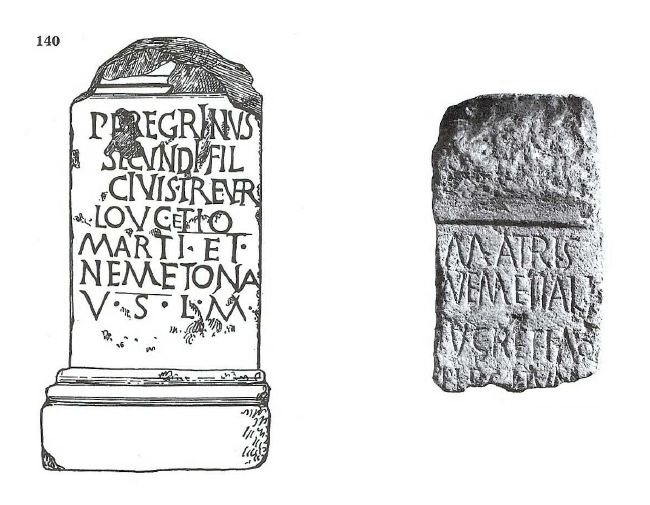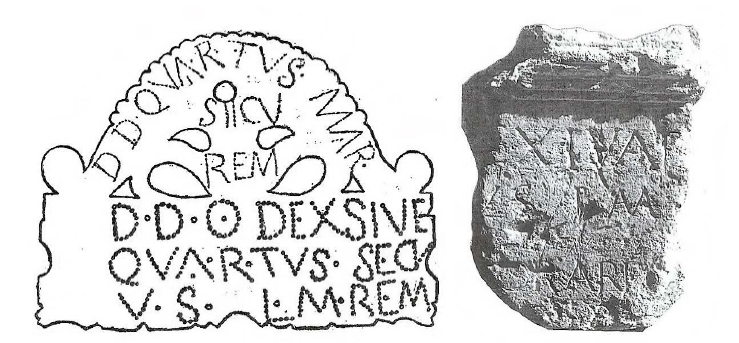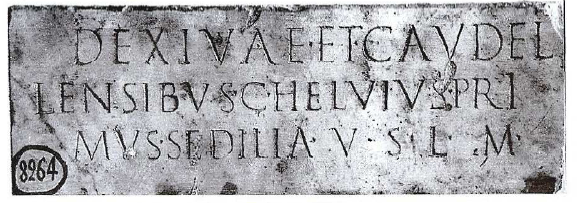A) Gallo-British Ethnonyms*
In the north-east of Gaul, several names of goddesses refer to Celtic and sometimes Germanic tribes. In Bavay, a small town situated between Valenciennes and Maubeuge (Nord), an inscription dedicated to collective goddesses called Nervinae was for instance discovered: Nervinis C(aius) Iul(ius) Tertius vslm, ‘To the Nervinae, Caius Iulius Tertius paid his vow willingly and deservedly’.1235 The dedicator bears Latin names and the tria nomina of Roman citizens. On account of their name and the place of discovery of the dedication, the Nervinae may be the eponymous goddesses of the Nervii, one of the most powerful Belgic tribes inhabiting the area between the River Sambre and the River Escault and neighbouring the Eburones, the Atrebates, the Viromandui and the Ambiani.1236
Similarly, an inscription found in Cologne (Germany Inferior) metions the Matres Remae: Matrib(us) Remis Bitorius Bellicus, ‘To the Mother Goddesses Remae Bitorius Bellicus’.1237Interestingly, the dedicator bears two Latinized names of Celtic origin: Bitorius, based on bitu-, biti-, bito-, ‘world’, and Bellicus, derived from beli-, belli-, belo-, bello-, ‘strong’, ‘powerful’.1238 The Matres Remae have an epithet referring to the name of the tribe of the Remi (‘The First Ones’, ‘The Most Ancient Ones’ or ‘the Princes’ (<* prei-mo-i)), who were located in present-day Champagne-Ardennes, in the north-east of France.1239 They may thus be understood as the ‘Mother Goddesses of the tribe of the Remae’.
The Matres Treverae, venerated in Birten, in the territory of the Cugerni (Germany Inferior), are undoubtedly the Mother Goddesses of the tribe of the Treveri, whose name might mean ‘guides’, ‘directors’, that is ‘those who help crossing the river, maybe the Moselle’.1240 The Treveri were a powerful sept* located in modern-day Luxembourg and its environs. The inscription is the following: Matribus Treveris T. Paternius Perpetus Cornicular Leg(io) XXX VSLM, ‘To the Matres Treverae, T. Paternius Perpetus Cornicular Legion XXX paid his vow willingly and deservedly’.1241 The dedicator has Latin names and is a soldier in the legion* XXX of the Roman army.
The instance of the Matres Nemetiales, mentioned in an inscription, probably dating from the 2nd c. AD, discovered in 1822 in the cemetery of the ancient church of Saint-Jean, in Grenoble (Isère), is less probable but worth mentioning though: Matris Nemetiali(bus?) Lucretia […] Q(uinti) Lib(erta) VM, ‘To the Matres Nemetiales (or to the Matres and to Nemetialis) Lucretia […] freed from Quintus […]’ (fig. 1).1242 Their epithet could be related to the Nemetes, a tribe probably of Germanic origin, who neighboured the Vangiones and the Triboci in Germania in the first half of the 1st c. BC.1243 It may also be the case of the goddess Nemetona, honoured in five inscriptions from Trier, in the sanctuary of the Altbachtal: Mart[i et] Nem[etonae] SCPE[, ‘To Mars and Nemetona [...]’,1244 Ne]met[onae (?), ‘To Nemetona’;1245 in Klein-Winternheim, near Mainz (Germania Superior): Nemeton(ae) v.s.l.m., ‘To Nemetona (the dedicator) paid his vow willingly and deservedly’;1246 in Altrip (Germania Superior): Marti et Nemetonae Silvini Iustus et Dubitatus vsll p(osuerunt), ‘To Mars and Nemetona Silvinus Iustus and Dubitatus paid their vow willingly and deservedly’;1247 and Bath (GB): Peregrinus Secundi fil(ius) civis Trever Loucetio Marti et Nemetona v.s.l.m., ‘Peregrinus, son of Secundus, a Treveran, to Loucetius Mars and Nemetona willingly and deservedly fulfilled his vow’ (fig. 1).1248 The ethnonym* Nemetes and the divine names or epithets Nemetona and Nemetiales must be derived from Gaulish nemeton signifying ‘sanctuary’ or ‘sacred grove’.1249 The Matres Nemetiales can therefore be understood as ‘The Mothers of the Sacred Grove or Enclosure’ and Nemetona ‘Sacred Grove’ or ‘Sanctuary’.1250 The distribution of the dedications to Nemetona and to the Matres Nemetiales - in the dedication from Bath, the dedicator specifies he is from the city of the Treveri - tends to prove that they were the tribal-goddesses of the Nemetes. Nonetheless, the idea of a goddess embodying the nemeton (‘sanctuary’ or ‘grove’) remains quite possible and should not be dismissed.
As for the Matres/Matronae Senonae, honoured in Metz (Mozelle) and Boeckingen (Germany): Seno(nibus) Matro(nis) coh(ors) I Helvet(iorum) […] v.s.l.m., ‘To the Matronae Senonae Cohort I of Helvetia [...] paid the vow willingly and deservedly’,1251 these are etymologically linked to the tribe of the Senones (‘The Old Ones’, from Gaulish seno, ‘old’), settled in the present-day region of the Sénonnais (France), that is the départements of Yonne, Aube, Seine-et-Marne and Côte d’Or.1252 In Gallo-Roman times, Sens, which is reminiscent of their name, was their capital under the name of Agendicum.

It is worth noting that the byname* Mattiaca given to Diana in the inscription from Wiesbaden (Germany),1253 may have been either a descriptive epithet of her character, that is Diana ‘the Favourable’, or of her function Diana the ‘Bear’, or an ethnonymic* epithet referring the Mattiaci (‘The Good People?’), a sept* of probably Germanic origin, which inhabited the area of today Wiesbaden, the southern Taunus mountain range and the tract of Wetterau, on the right side of the Rhine, between the tribes of the Cugerni and Chatti.1254As the dedication was found in Wiesbaden, it is highly likely that this Diana Mattiaca is to be understood as the ‘Diana belonging to the tribe of the Mattiaci’, that is the Diana who protects and presides over them.
As for the Matronae Gesahenae, venerated in Roedingen, Bettenhofen, Deutz and Cologne (Germany)1255 and the Matronae Gesationum, mentioned in an inscription from Iülich (Germany),1256 they might be related to the Gaulish tribe of the Gaesati (‘Armed with Spears’ or ‘Lancers’), who were settled along the Rhône, but this remains a hypothesis.1257
Similarly, on account of their name, the Matres Eburnicae, venerated in Yvours-sur-le-Rhône (Rhône),1258 may have come from the name of the Eburones, who were settled in the area north of the Ardennes, between the Meuse and the Rhine, north of the Atuatuci.1259 This hypothesis howver implies a linguistic transformation Eburonikā > Eburnikā, and as the inscription was found far away from the area of settlement of the Eburones, it is difficult to affirm that the Eburnicae are ethnonymic* goddesses. They are more likely to be understood as devotees of the yew, a tree which, as we have seen, was sacred for the Celts.
In the south-east of Gaul, the Matronae Vediantiae, honoured in Cimiez (Nice, Alpes-Maritimes), are ‘the Mother Goddesses of the Vediantii’, a small sept* inhabiting along the coast between the mouth of the River Var and Monaco Bay to the east of Mont-Agel.1260 The two inscriptions mentioning the Mother Goddesses are the following: Matronis Vediantiabus P(ublius) Enistalius P(ubli) f(ilius), ‘To the Mother Goddesses Vediantiae, Publius Enistalius, son of Publius’ and [--deab]us Vedia[ntiabus--], ‘To the Goddesses Vediantiae’.1261 It is interesting to note that the first name of the dedicator, which he took from his Romanized father Publius, is Latin, while his second name Enistalius is Celtic.1262 This is indicative of his attachment to his indigenous roots and cults, all the more since he was from a place which had been under Roman influence for a long time. According to Barruol, those Mother Goddesses are “eponymous of the country and protectresses of its inhabitants”.1263
Another significant example is the goddess Dex(s)iva, known from four inscriptions discovered at the location of the 1.5-hectare oppidum* of the Castellar in Cadenet (Vaucluse). This oppidum* was occupied from the2nd c. BC to the 3rd c. AD and is regarded as the siege of the tribe of the Dexivates.1264 The first inscription was discovered before 1572 either in Pertuis or in Cadenet and is now lost: Dexsivae v(otum) s(olvit) l(ibens) m(erito) A(ulus) Com(inius) Suc(cessus), ‘To Dexsiva, Aulus Cominius Successus paid his vow willingly and deservedly’.1265 The dedicator bears Latin names and the tria nomina of Roman citizens. The second inscription, found in 1817 and now lost, was engraved on a plaque in tin or gold with a semi-circular top and two holes reading: D(onum) d(at) Quartus Mar(ti) securem D(onum) d(at) o(…) Dexsive Quartus securem v(otum) s(olvit) l(ibens) m(erito), ‘Quartus offers an axe to Mars. Quartus offers […] an axe to Dexsiva’ (fig. 2).1266 Her association with Mars in this dedication led her to be understood as his partner. This is however unlikely, the association being indirect and different from the usual dedications made to divine couples. According to Benoit, the axe she is offered is a symbol of protection in everyday life as well as in the afterlife.1267 The third inscription, engraved on a marble plaque, was found in 1773 together with treasure containing two vases in silver, coins, jewels and various objects:1268 Dexivae et Caudellensibus C(aius) Helvius Primus sedilia v(otum) s(olvit) l(ibens) m(erito), ‘Gaius Helvius Primus paid his vow willingly and deservedly to Dexiva and the Caudellenses in offering seats or benches’ (fig. 3).1269 Here Dexiva is honoured with collective deities, called Caudellenses, known by this single inscription, who are, in the words of Barruol, domestic goddesses “eponymous of a habitat”.1270 The fact that the dedicator offers seats or benches to the goddesses indicates the existence of a temple dedicated to them on the hill of the Castellar, for such benches were set up for the pilgrims to rest when they went to the temple to pray.1271 The last inscription, probably dating from the 1st or 2nd c., is engraved on a damaged altar: [D]exivae v(otum) s(olvit) l(ibens) m(erito) [.]ORARP[., ‘To Dexiva (…) paid his vow willingly and deservedly’ (fig. 2).1272 As Barruol argues, the goddess Dexiva is definitely to be related to the tribe of the Dexviates or Dexivates, mentioned by Pliny in Natural History, who inhabited the area between the Lubéron and the river Durance and had a sanctuary on the oppidum* of the Castellar.1273 In addition to the similarity in names, the inscriptions were all discovered on this site, which tends to prove that Dexiva was the protectress of this sept* and of their city. The name of the Dexivates and Dexiva may denote good fortune. They are based on an adjective deksiuo- meaning ‘southwards’ and ‘on the right, favourable’ in Celtic. According to Delamarre, Dexiva is ‘the one who is southwards or on the right’, i.e. ‘The Favourable One’.1274


The most illustrious example of a ‘tribal-goddess’ is certainly Brigantia, who, as her name indicates, is the eponymous goddess of the powerful tribe of the Brigantes. The fact that the seven inscriptions dedicated to her were discovered in the region inhabited by the Brigantes confirms that theory.1275 The inscriptions were indeed found in South West Yorkshire and in the area of Hadrian’s Wall and Ptolemy and Tacitus record that the Brigantes were situated in present-day Yorkshire and Northumbria.1276 Ó hÓgáin argues that the Brigantes might originally have been a branch of the Eburovices and took on a new name when they settled in the area of the Pennines, for their stronghold was called Eburacon (York).1277 It is also interesting to note that a mountain sept*, located in the Alps, in the present-day Briançonnais, bore the name of Brigianii.1278 Their name could indicate that they had blood ties with the Brigantes,1279 but it is more probably redolent of their mountain location, brig- referring to highness. Around 50 AD, the King of the Brigantes, Venutios, rebelled against the Roman invaders with a part of his people, while his wife, Queen Cartimandua, became allied with them. The Brigantes were eventually subjected to Roman authority by Petilius Cerialis between 71 and 74 AD.1280 The seven inscriptions dedicated to Brigantia are from around the end of the 2nd c. AD to the beginning of the 3rd c. AD, when the cult of this goddess was officially encouraged by the Romans (Severan Dynasty).1281 As we saw in Chapter 2, Brigantia is etymologically linked to Irish Brigit, which is not insignificant. The name and cult of this goddess may have been brought to Ireland by members of the Brigantes tribe, who crossed the sea to find new lands, probably already in Celtic times, and around the 1st c. AD, to escape from the Roman invasion and influence.1282 This is very likely, for Ptolemy, in his Geography, mentions a tribe of this name in South Wexford.1283 According to Ó hÓgáin, the septs* of the Lagini, situated in the east-centre of Ireland, and the Barreki, settled in the south-east, contained offshoots of the Brigantes.1284
From this, it follows that there are many examples of goddess eponymous of tribes in Britain and Gaul, the largest group coming from the north-east and south-east of Gaul. Dexiva of the Dexivates and Brigantia of the Brigantes are substantial instances of such cult. Apart from Brigantia, whose functions can be deduced from her equation with Roman goddesses and her iconography, the essence, attributes and roles of those Gaulish ‘tribal’ goddesses remain unclear, for they are known only by epigraphic evidence. The study of the Irish territorial-goddesses, patronesses respectively of a region and of a tribe, may cast new light on that question. They could be taken as an illustration and could give an interesting perspective to the subject.